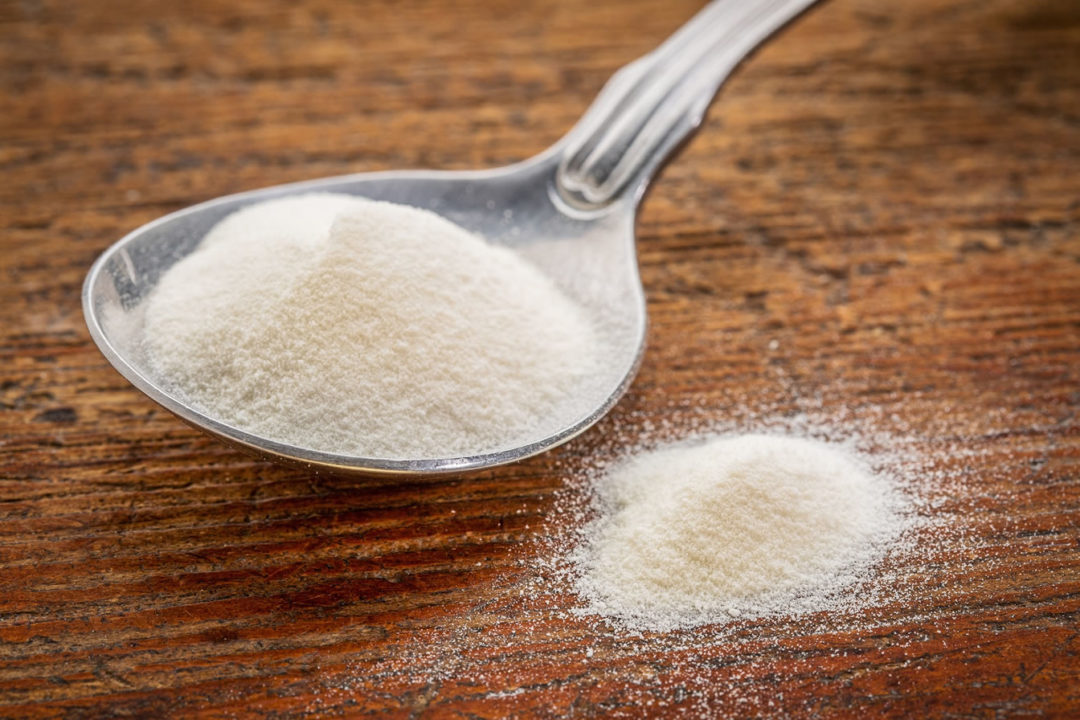You may have noticed that collagen products are showing up everywhere. There are collagen protein powders, collagen supplements, and an endless selection of collagen skin products.
So what’s the deal?
Collagen is the most abundant protein in the body, making up approximately 30% of our whole-body protein content. The word itself comes from the Greek wordkollawhich means glue—and indeed, in a very real sense, collagen is the glue that holds stuff together—tendons, joints, bones, muscles, and especially skin are all dependent on collagen. Without collagen, you’d pretty much fall apart.
Collagen is produced in the underlying layer of the skin known as thedermis. My colleague Vera Tweed explained how it works brilliantly in an article inBetter Nutrition. She likened the dermis to a mattress and the outer skin layer — theepidermis — to bed sheets. “When collagen starts to break down”, she wrote, “we end up with an old, saggy ‘mattress’ that wrinkles the sheets.”
There are actually more than 16 types of collagen in the human body, but three of them — simply called Type 1, Type 2 and Type 3 — are predominant, accounting for up to 90% of the collagen in the body (1). All collagen has an abundance of three specific amino acids: glycine, proline, and hydroxyproline, but the three main types of collagen are concentrated in different places in the body. Type 1 and 3 are in the skin, as well as the tendons and bones. Type 2 is mainly in cartilage, one reason it has come to be known as “good for the joints.” (More on that in a moment.)
Collagen and gelatin have an interesting relationship and are frequently spoken of as equivalent, though technically they’re not. All collagen comes from animal products, and is actually found in the toughest, most grisly pieces of meat, cuts of meat that contain the most connective tissue and aren’t exactly the most popular on anyone’s menu. When you cook those tough cuts of meats, or simmer beef bones in a crockpot (bone broth, anyone?) you’re essentially cooking the collagen, which produces gelatin. So a fast way to remember the distinction is that gelatin is basically cooked collagen. (Gelatin is one of the main reasons bone broth is so nutritious. It’s also highly anti-inflammatory.)
Once collagen is extracted from its sources (like grass-fed beef hides) it’s processed in either of two ways. One of those ways produces gelatin, but a second, slightly different way produces something called collagen hydrolysate, also known as hydrolyzed collagen. Hydrolyzed collagen is just more easily digestible collagen. The protein molecules have been broken down into smaller and smaller “pieces” — usable small chain peptides and amino acids, units much easier for the body to assimilate and use. The better supplements all use hydrolyzed collagen.
So what’s the problem with collagen?
The only “problem” with collagen is that there just isn’t enough of it. Remember, collagen is the connective tissue for just about everything — the heart, skin, muscles, hair, arteries, discs, cartilage, nails, liver — you name it. And, as is so often the case, nature plays a little trick on us by slowing down production in collagen as we get older. The activity of the cells (known asfibroblasts) that actuallymakecollagen, elastin and hyaluronic acid slow down. And that’s where things get hairy.
When you don’t have enough collagen your muscles and skin start to sag. Your bones can lose mineral density. Cartilage starts to thin out, and becomes weaker. The skin thins and becomes wrinkled. A decreased amount of collagen in the bones is one of the underlying causes of bone problems. “If the collagen content is low,” says Dr. Michael Murray, “the bone becomes more brittle and fracture risk increases dramatically.”
And collagen is beginning to be recognized for so much more than keeping your skin young. A recent article inMen’s Journalprofiled a new, high-tech way of monitoring your biological age system by system (i.e. cardiovascular, neurological, muscular, and pulmonary). It turns out that the deterioration of connective tissue like collagen not only ages the arteries, but ages the lungs as well as reducing the amount of air we can take in and blow out. On top of everything else, collagen stores are turning out to be a marker for lung health!
So for all these reasons, I’ve come to rely on collagen supplements and they’ve been a part of my health regimen since about 2003. (For anyone who’s curious, the brand I personally use is Reserveage. Highly recommended.)
Jonny Bowden, “the Nutrition Myth Buster” is a board-certified nutritionist and the
 best-selling author of 15 books including The Great Cholesterol Myth, Living Low Carb, the 150 Healthiest Foods On Earth and Smart Fat. To learn more about healthy living, motivation and nutrition, visit jonnybowden.com.
best-selling author of 15 books including The Great Cholesterol Myth, Living Low Carb, the 150 Healthiest Foods On Earth and Smart Fat. To learn more about healthy living, motivation and nutrition, visit jonnybowden.com. Note: The statements presented in this column should not be considered medical advice or a way to diagnose or treat any disease or illness. Dietary supplements do not treat, cure or prevent any disease. Always seek the advice of a medical professional before altering your daily dietary regimen. The opinions presented here are those of the writer.
Posted on WholeFoods Magazine Online, 3/2/17










